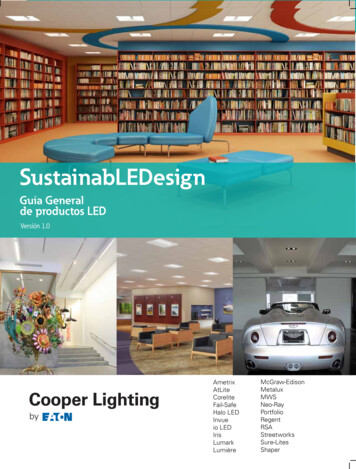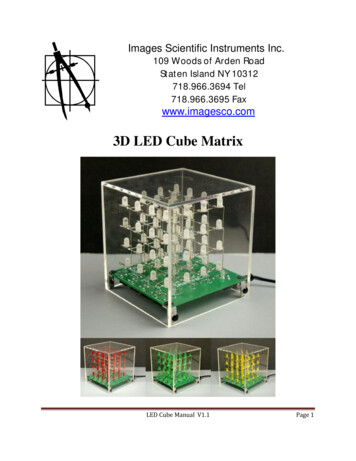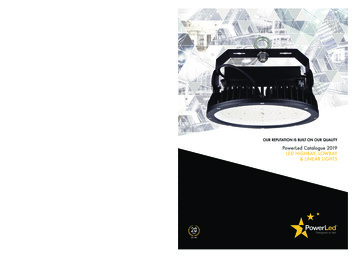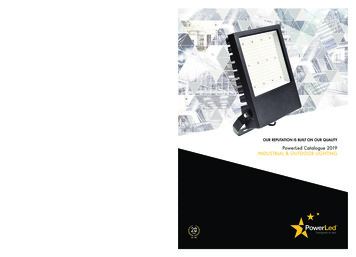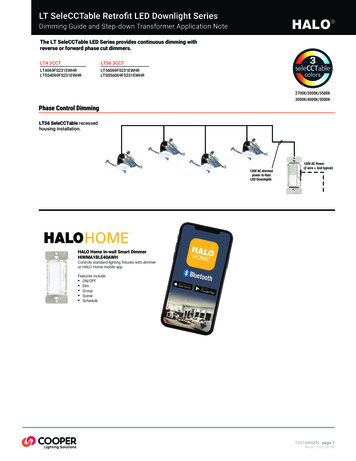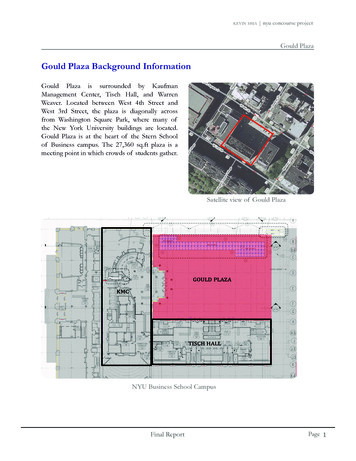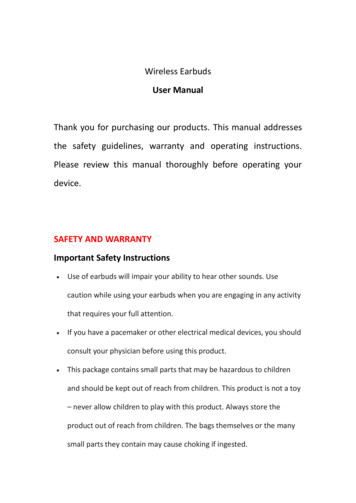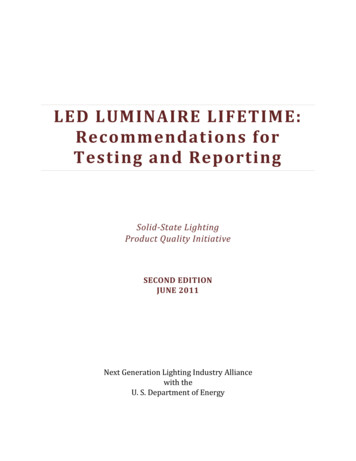
Transcription
LED LUMINAIRE LIFETIME:Recommendations forTesting and ReportingSolid-State LightingProduct Quality InitiativeSECOND EDITIONJUNE 2011Next Generation Lighting Industry Alliancewith theU. S. Department of Energy
CONTENTSIntroduction . 3Understanding SSL Luminaire Lifetime . 3What This Guide Is and Is Not . 4Failure, Reliability, and Lifetime . 5Reliable Design and Manufacturing . 8End of Life . 11Serviceability and Lifetime . 12Lifetime for Non-Serviceable LED-Based Luminaires . 12Lifetime for Serviceable LED-Based Luminaires . 13Key Issues for Reliability and Lifetime . 14LED Lumen Depreciation . 14LED Drivers and Controls . 14Types of Power Conversion . 15LED Drivers . 15Standards, Regulations, and Protection. 16Color Shift . 17Relation of Color Shift to Lifetime . 17Segmentation of the Luminaire Market . 21Standards and Measurement Work. 21Specifying and Demonstrating Lifetime . 22Lifetime Specification. 22Optional Specifications . 23Determining and Maintaining Specified Lifetime. 24New Platform Lumen Maintenance . 24Product Variation of New Platform . 25Additional Considerations . 26Design for System Reliability . 26Labeling Recommendations . 27Other Options . 27The Role of Warranties. 28Recommended Further Reading . 29Acknowledgements . 30LED Luminaire Lifetime Recommendations, June 2011Page 2
INTRODUCTIONUNDERSTANDING SSL LUMINAIRE LIFETIMESurprisingly to many, the true reliability and lifetime of light-emitting diode (LED) lighting systemsis generally not known. Even worse, lumen maintenance values of LED devices are widely used as aproxy for the lifetime of an LED lighting system, which is misleading since lumen maintenance isbut one component of a luminaire’s reliability. In fact, quite often the lifetime of a well-designed andmanufactured luminaire is not determined by LED lumen depreciation. For many manufacturersestimating the luminaire lifetime using LED lumen maintenance, results can be ascribed todependence on readily available numbers without developing actual luminaire data. In many cases,neither product providers nor customers are aware of the differences, perhaps in part because theproblem has not been sufficiently explored and communicated.It isn’t just about the LED. Good LEDs can be incorporated into poorly engineered products andturn the Methuselah of lighting into the exponent of “live fast, die young.” The promise of LEDlifetime is often presented in terms of hours and years but with little background data. Warrantiesas well may be misstated because of this lack of data, at the manufacturer’s peril. The statement“100,000 hours of LED luminaire lifetime” is gradually giving way to the realization that there islittle consistency, very little published data, and few hard facts around so-called luminaire lifetimenumbers. The situation is better at the LED package level, where reputable manufacturers havethousands of hours of data under varying conditions. But this is not enough.To manufacturers and specifiers in the solid-state lighting (SSL) community, the dawningrealization is that we need to work together toward understanding the issues surrounding truelifetime and reliability. We need to begin by cataloguing failures and developing good models forunderlying failure mechanisms. This process of understanding and explanation is very common intechnological progress—steam engines existed long before deep comprehension of thermodynamicprocesses. With LEDs, we have a substantial head start on the underlying physics, many years ofexperience in both lighting and semiconductors, and reliability of related products.As stated in the first edition of this guide, released in June 2010, there is no reason not to begin thisjourney and every reason to start. Now, one year later, we continue to pursue better reliabilitymethods and metrics and explore the underlying root causes of failure.LED Luminaire Lifetime Recommendations, June 2011Page 3
WHAT THIS GUIDE IS AND IS NOTLike the first edition of the guide, this second edition is a setof recommendations for reporting and demonstratingluminaire product lifetime. Initially, we sought to provideguidance for the Lighting Facts program, which gives users,retailers, and manufacturers a common short-form reportingmechanism to improve the quality of solid-state lightingproducts on the market. The Lighting Facts label provides asummary of key performance criteria but does not includelifetime, for which there have been numerous requests.Ideally, it would be the addition of a single number, e.g., “eightyears.” We attempted, in the first edition, to suggest somedescriptions which would better describe lifetime, and it isfair to say that there are fewer wild claims in the marketplace.Yet there is still not an accepted protocol for measuring andcharacterizing lifetime. In part, this is due to cost, as a fairnumber of product samples must be tested to get goodnumbers, but it is also due in some measure to the industry’searly emphasis on lumen depreciation. Until recently, LEDproducts have been described as “different” fromconventional technologies—LEDs will just get dimmer untilthey fade away. But as we learn more about the behavior ofthese LED “systems,” it becomes evident that the life of afixture may be considerably shorter than what is indicated bynominal light depreciation, albeit still generally longer thanmany incumbent lighting solutions.This edition addresses a number of these issues and attemptsto clarify the general understanding of reliability and how itpertains to lifetime; explore methods of estimating andcharacterizing lifetime; distinguish between types of failureand failure modes; look at differences between repairable andnon-repairable systems; and revisit the definition of productlife. It remains important to keep the SSL community focusedon this issue. Cooperatively, it should be possible to developsufficient data and best practices so that lifetime may be moreaccurately and more simply described.These recommendations have been developed by a workinggroup under the guidance of SSL Quality Advocates, a jointinitiative of the DOE Solid-State Lighting Program and theNext Generation Lighting Industry Alliance (NGLIA). Theworking group is composed of members of NGLIA as well asother experts in reliability, lighting, and LED technology. Assuch, this guide is not an accepted international standard.Rather, it is meant to provide standards bodies withLED Luminaire Lifetime Recommendations, June 2011This guide contains numerousrecommendations and observationswith a primary emphasis on thedefinition of lifetime, and secondaryemphases on the following: Lumen depreciation is not aproxy for lifetime (Introduction)Consider only light output indefining lifetime (p. 5)Use overstress testing to identifydesign flaws and manufacturingdefects (p. 10)Indicate if a product isserviceable or not (p. 13)LM-80 data can predict lumendepreciation but not lifetime (p. 14)Develop standard ways tocharacterize drivers for SSL use(p. 16)End of life as defined in thisdocument excludes color shift(p. 17)To deal with color shift, designateproducts in one of threecategories (p. 21)Develop standard qualitativedescriptions of the degree ofcolor shift (p. 21)Define standard luminairelifetime (p. 22)Reported lifetime should have atleast a 50% confidence level(p. 24)Use LM-79 for full luminairecharacterization (p. 24)Develop and document a changecontrol process (p. 26)Develop a capability for statisticalsystem design for reliability(p. 26)Add standard LED luminairelifetime to the Lighting Facts label (p. 27)Page 4
recommendations for their work in supporting the needs of the SSL community. Theseorganizations will ultimately determine the details of the methods to measure and report thereliability of SSL luminaire products.This guide covers only luminaire lifetime—i.e., changes over time —and does not address initialperformance criteria or product consistency. Initial performance criteria for LED luminaires havebeen separately discussed in the December 2008 publication Reporting LED Luminaire ProductPerformance, found on the DOE SSL website ons/pdfs/ssl/led productperformanceguide.pdf.FAILURE, RELIABILITY, AND LIFETIME“Reliability” and “lifetime” are not synonyms. They are two separate and equally useful valuesreported by a component or subsystem manufacturer. A “failure” is an event which ends the life of aspecific product or component, but may need definition if that end is not immediately evident, as isthe case with lumen depreciation. Usually a luminaire or lamp design will encompass a number ofinterdependent components and subsystems, each with different lifetime and reliability values. It isnot normally appropriate to use the worst or best case of these values; rather, the system needs tobe evaluated as a whole because there can be inter-device effects (such as thermal impacts) thatneed to be taken into account.Lifetime is an estimate of how long any single product is expected to operate as intended, given aspecific set of environmental and mechanical requirements. Intuitively, we understand aluminaire’s “lifetime” or “end of life” to be when it no longer emits light. For conventional lightingtechnologies, the “rated life” of a lamp, for example, is usually considered to be the time when halfof the lamps have failed (B50). However, we’ve learned that LEDs fade over time, and so we’vemodified our definition to mean “when there’s no longer enough light,” sometimes defined as“useful life.” But sometimes only lumen depreciation is considered, and then, often, only the lumendepreciation of the LEDs is considered in estimating useful life of the luminaire product. Each is aproblem, since failure or degradation of drivers, optics, or other components can lead to either totalfailure, in the traditional sense, or accelerated lumen depreciation of the LEDs. Lifetime does notconsider repair or replacement, either of premature failures or in the course of normal maintenanceof a serviceable system, although the ability to service can be a valuable attribute of a product.It is also important to appreciate that insufficient or no light output is not the only reason a productmay no longer be acceptable. Other reasons include excessive color shift or changes in lightdistribution due to failure of some but not all of the LEDs. Whether or not to include theseadditional failures in defining lifetime can be a difficult question. In the first edition of this guide,the recommendation was to consider only light output in defining lifetime, but to consider allsources of diminution or failure of light output when arriving at the number. That remains ourposition but we will address the color shift issue, in particular, in more detail in this document.Failure, as noted above, is an event pertaining to a specific unit of a product or component. Failureof any part may lead to failure of the whole. Some performance degradation of a driver, even shortof ending that component’s life, could, however, result in failure of the LEDs. Such interactionsamong components need to be considered in estimating system failure rates (reliability). BecauseLED Luminaire Lifetime Recommendations, June 2011Page 5
the LEDs themselves are expected to have a long, useful life, all other components, adhesives, andmaterials should also be long-lived, at least to the extent they do not result in an inappropriatelyshortened life. This last phrase is key: While it may be possible to design the other components tohave equally long lives, or even longer lives than the LEDs, that may not be the most cost-effectivesolution for the application. The underlying objective of designing for long life is identifying theappropriate balance between statistical certainty and cost. If cost were unconstrained, an extremelylong-life, highly reliable system could be designed—although, even in this case, random failureswould be expected. Practically, the luminaire should be designed so that there is an acceptable levelof failure over the anticipated lifetime of the system for a reasonable cost. Above all, it is importantthat the claims match the performance and that customer expectations are met.Reliability, as defined by the Institute of Electrical and Electronic Engineers (IEEE) and others, is theability of a system or component to perform its required functions under stated conditions for aspecified period of time. It is often reported as Mean Time Between Failures (MTBF) asdistinguished from Mean Time To Failure (MTTF). (When the failure times are normallydistributed, the mean and median [B50] times to failure are the same, but for other distributionsthey may be different.) MTBF is an especially useful measure when the system is repairable, as itwill determine the maintenance interval. The average time of random failure is calculated bydividing MTBF by a population size. For example, if there are 1,000 devices with an MTBF of100,000 hours, it is expected that there will be a random failure every 100 hours.For electronics, the performance of a system composed of a number of components is typicallycharacterized by an initial high failure rate (infant mortality period), followed by a long period witha low rate of random failures, concluding with a high failure rate at the wearout period or end oflife. The random failures between initial failures and end-of-life wearout are essentially determinedby the tails of these distributions. Figure 1 shows what is commonly known as a “bathtub” curvedepicting that behavior.0.070.06Wearout0.050.040.03Proba blity of Failure0.02Early Failures0.010TimeFIGURE 1. THE “BATHTUB” CURVE ILLUSTRATING TYPICAL FAILURE BEHAVIOR OVERTIME OF AN ELECTRONIC SYSTEMLED Luminaire Lifetime Recommendations, June 2011Page 6
A similar behavior might be expected for a luminaire system, but because LED technology is stillrather new, we should also be conscious of another contributor to failure: design flaws. Though notreally a part of estimating product lifetime, design flaws are a reality of the current state of the artthat needs to be addressed. Thus, we have divided reliability issues for discussion in this guide intothree main categories:1. Design flaws. As the first LED lighting products appeared on the market, many design flawswere evident. The most common, initially, was poor design (or no design) of heat removalfrom the chips. This problem often resulted in overheated chips for which the luminousoutput depreciated quickly, leading to short-lived products. It was further exacerbated byclaims that were essentially based on the LED lumen depreciation data. Design flaws, whileperhaps less common and more subtle than they were only a short time ago, still exist: poorthermal management; using incompatible chemicals which degrade the optics or the chips;poorly matching the driver to the LED requirements; overdriving the chips; poor sealsallowing moisture penetration, and so forth. Problems of this sort should largely diminish asdesigners become more familiar with the technology, so that claims more closely matchperformance. Choices of drive current and operating temperature, especially, will affect thedesign life of a product—an important concept that is appropriate engineering for costcontrol. Slipshod design leads to unpredictable design life; a product with a predictabledesign life that is advertised accurately and appropriately priced will satisfy a customerneed far better than one with excessive and almost surely unmet claims of “lasting forever.”2. Manufacturing defects. These will always be with us. Even with a well-designed product,excursions from process control occur from time to time. Usually, these defects result inearly failures. They may be partially covered by warranties, but that may still beunsatisfactory if the incidence of failure is too high. At present this does not seem to be anoverly serious issue, at least with the major manufacturers, but as the volumes rise and asless experienced manufacturers enter the market, it is important that close attention bepaid to quality controls. Factory testing and “burn-in” can also help. These can lead toadditional costs, but can also minimize the customer seeing the early failures.3. End of life. A well-designed system operated under normal conditions within specificationswill, nonetheless, eventually fail. There may be two or three critical modes of failure thateventually make the system unusable. With well-made components, the time of this failureshould be fairly predictable, at least within a range, and this is what lighting users havecome to expect is the “lifetime” of the luminaire. Understanding how to evaluate a systemand predict end of life accurately is very important for market acceptance of solid-statelighting. It is the focus of the discussions in this guide.There is no standardized method to determine lifetime, but for many electronic systems it can beand is typically estimated using the predicted lifetime of individual components at the anticipatedoperating conditions, which are then statistically combined. We do not have sufficient informationtoday on all of the components and interactions of a luminaire to make these predictions. However,that should ultimately be our goal because for now, absent that data, the only remaining option toestimate system MTTF or B50 is to do a full LM-79 luminaire test on a population of product, whichposes a conundrum. For many manufacturers a full LM-79 test may be too expensive and timeconsuming. We recommend the full LM-79 test to establish lifetime, taking into account allfailure mechanisms, but to address this difficulty we also suggest a number of alternativeLED Luminaire Lifetime Recommendations, June 2011Page 7
approaches to provide some indications of reliable design, if not of true lifetime. (See LabelingRecommendations on page 27.)The remainder of this section describes additional aspects of some of the above contributors toproduct reliability.RELIABLE DESIGN AND MANUFACTURINGFailures within an SSL luminaire often stem from at least one of four functional aspects of luminairedesign and manufacturing: power management, thermal management, optical management, andluminaire assembly integrity.Figure 2 provides an overview of a contemporary SSL luminaire and the relationships between thevarious components and materials and design elements.SSL Reliability Management(luminaire design, components, final assembly and test)Thermal ManagementPowerInputPowerSupplyDriver(If used)LEDPackagePower ManagementFocalLens(If used)Reflectors(If used)Diffuser(If used)LightOutputOptical ManagementLuminaire Assembly IntegritySource: Appalachian Lighting Systems, Inc.FIGURE 2. SSL LUMINAIRE COMPONENTS AND RELIABILITY CONSIDERATIONSSOURCE: APPALACHIAN LIGHTING SYSTEMS, INC.Design goals and reliability impacts for each of these four functional aspects are described below. Power Management – ensuring the power delivered to the LED package(s) isappropriately sized and filtered.ooDesign Goals: For proper operation, the power supply and related electronics must provide awell-controlled and protected (from electrical transients) drive current and possibly othercontrol and monitoring features, and must be designed to properly function for theanticipated life of the product.Reliability Impact: Component failures due to improperly designed and executed powermanagement may often result in a catastrophic failure of the luminaire, but they can alsocause less obvious effects, such as reduced light output or flicker. Proper power managementLED Luminaire Lifetime Recommendations, June 2011Page 8
includes protection against failure caused by electrical transients. This protection might bebuilt into the driver or might be a separate subsystem of the luminaire.Thermal Management – ensuring that heat generated by the LED package(s) and thepower system components is removed to minimize LED temperatures so as to maximizeLED performance and lifetime.oo Reliability Impact: Improperly designed and executed thermal management will usuallyresult in accelerated lumen depreciation and potentially degraded color quality or color shiftof the LED package(s).Optical Management – ensuring that light output from the LED package(s) is correctly andefficiently shaped and directed toward the desired surface.oo Design Goals: A reliable heat-conducting design, be it passive or active, is required to removeheat from the LED package and luminaire, and phosphor, if applicable. The design shouldassure that the LED package operates below a manufacturer-reported LM-80 measurementtemperature to achieve the desired lumen maintenance of the fixture (an ENERGY STAR requirement). Also, the design must assure that temperatures for other devices (powersupply, control circuitry, optical components, etc.) do not exceed the manufacturer’sspecified limits.Design Goals: Component choices and manufacturing methods should be chosen so that theoptical materials retain their integrity throughout the life of the product; it is desirable thatsuch components not be life-determining.Reliability Impact: Optical component failures may degrade lumen output of the luminaire’sLED package(s) or, because of discoloring, may also result in a color shift, but rarely result incatastrophic failure.Assembly Integrity – ensuring that the overall housing design and assembly process(es)provide for sufficient long-term protection from dust, moisture, vibration, and otheradverse environmental effects.ooDesign Goals: Luminaire housing design and materials must be designed to offer sufficientprotection for the LEDs depending on the anticipated environment. Repairable designsshould allow simple field replacement of any failed components without degrading theintegrity of the housing or other components.Reliability Impact: For outdoor or harsh environment applications, housing failure can leadto catastrophic failure of critical light-producing components. In other cases, mechanicalfailure may result from insufficient protection for internal components. Any assemblyprocess bears the risk of occasional random manufacturing defect failures that will occurthroughout the life of the product but should not seriously affect end-of-life wearout.SSL luminaire failure modes are often related, e.g., improper thermal management can lead topremature LED lumen depreciation and/or optical degradation and/or power component failure.The overall luminaire quality—and therefore the probability of satisfactory long-term luminaireperformance—is directly related to careful, thoughtful, and integrated luminaire design, componentselection, final assembly, testing, and packaging. Furthermore, well-documented installationinstructions—and actual installation coordination for complex or large-scale projects—can alsohave a major impact on initial and long-term luminaire performance.Even if the SSL luminaire is well designed to address all of the various failure modes, attention toproper manufacturing steps and quality process controls must be clearly documented and carefullyLED Luminaire Lifetime Recommendations, June 2011Page 9
executed. Any of the failure mechanisms inherent in electronic assemblies and other luminairecomponents may apply to an SSL luminaire.Figure 3 shows the frequency of various field failure modes that have been documented for a familyof outdoor SSL luminaires from a manufacturer’s installed base. For this example of a welldesigned set of products, the overall failure rate is very low and, interestingly, it depends only to asmall extent on the LED packages. (Note, however, that this product line example has not yetreached the end-of-life wearout stage, so it cannot be said that LED failure will not eventually havea larger role.)LED ontrolCircuit)7%FIGURE 3. DISTRIBUTION OF FAILURES IN 34M OPERATING HOURS FOR A FAMILY OFOUTDOOR LUMINAIRES. TOTAL NUMBER OF FAILURES WAS 29, OR 0.56% OF INSTALLEDBASE OF APPROXIMATELY 5,400 FIXTURES .SOURCE: APPALACHIAN LIGHTING SYSTEMS, INC.Over-stress testing is recommended as a useful approach for identifying design flaws ormanufacturing defects. Such tests can help to uncover root causes of a product’s prematuredemise. Selection of such tests is beyond the scope of this guide, but it may be worthy of furtherstudy by the industry and a sharing of best practices to promote the overall market. Thisinformation would be especially helpful for smaller manufacturers lacking the means to doextensive reliability qualification.Based on experience with the CALiPER 1 program, this guide recommends a minimum 1,000-hourburn-in (continuous use) test of a small number of products to verify that there are no serious,immediately apparent design flaws in a new platform. While this recommendation may be seen as abit vague and in no way guarantees a good design, any failures that occur in this short period oftime are a cause of concern that may warrant another look at the design before product release.1For more information on the CALiPER program, see www.ssl.energy.gov/caliper.html.LED Luminaire Lifetime Recommendations, June 2011Page 10
END OF LIFEDefining and estimating end of life for LED luminaires is complicated by the phenomenon of longterm lumen depreciation. For conventional technologies, the “rated average lamp life” is the point atwhich half the lamps cease to emit light. All sources lose light output (depreciate) during the ratedlamp life as defined by complete, “lights-out” failure of 50 percent of the population. However, awell-designed LED package or array typically would not fail entirely for a very long time.Consequently, th
Next Generation Lighting Industry Alliance (NGLIA). The working group is composed of members of NGLIA as well as other experts in reliability, lighting, and LED technology . As such, this guide is not an accepted international standard . Rather, it is meant to provide standards bo

